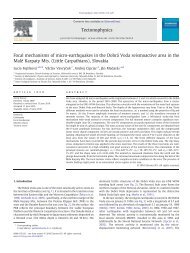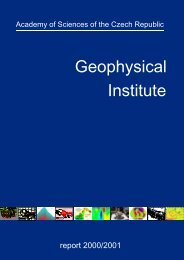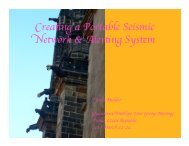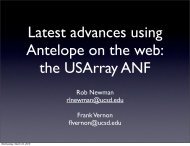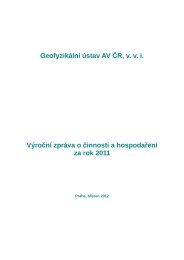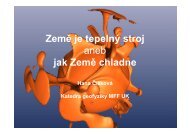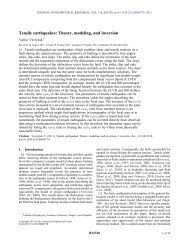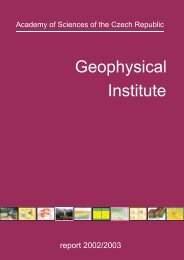Geophysical Institute of the ASCR
Geophysical Institute of the ASCR
Geophysical Institute of the ASCR
Create successful ePaper yourself
Turn your PDF publications into a flip-book with our unique Google optimized e-Paper software.
FeO 91%<br />
Al2O3 0,8%<br />
SiO2 0,2%<br />
MgO<br />
CdO<br />
ZnO<br />
Fig. 36. SEM images <strong>of</strong> typical<br />
magnetic spherules <strong>of</strong> anthropogenic<br />
origin, found in topsoil layers in<br />
industrially affected area near<br />
Ostrava, along with typical<br />
elemental composition.<br />
Present instruments and methods enable very sensitive determination <strong>of</strong> concentration <strong>of</strong> strong<br />
ferrimagnetics (for instance magnetite), in <strong>the</strong> order <strong>of</strong> ppm. Magnetic properties <strong>of</strong> soils have been<br />
recently beneficially used in examining industrial pollution. Methods <strong>of</strong> "environmental magnetism"<br />
are sensitive and enable detection <strong>of</strong> small changes in concentration <strong>of</strong> magnetic particles in soils<br />
(e.g., Petrovský and Ellwood, 1999). Deposited dust <strong>of</strong> anthropogenic origin comprises high portion<br />
(5 – 10%) <strong>of</strong> highly (ferri)magnetic particles, produced primarily during combustion <strong>of</strong> fossil fuels<br />
containing pyrite. Dissociation and oxidation processes during combustion form ferrimagnetic iron<br />
oxides from Fe ions. Resulting anthropogenic magnetite (Fe3O4) or maghemite (Fe2O3) form specific<br />
spherules with diameter from several micrometers to several tens <strong>of</strong> micrometers and <strong>the</strong>ir magnetic<br />
properties are different from particles <strong>of</strong> lithogenic origin. Besides combustion, industrial magnetic<br />
particles also result from, e.g., steel and cement industry and from road traffic (e.g., Petrovský and<br />
Ellwood, 1999).<br />
Magnetic susceptibility represents one <strong>of</strong> major parameters indicating concentration <strong>of</strong><br />
(ferri)magnetic particles in soils and sediments. Magnetic mapping (measurements <strong>of</strong> magnetic<br />
susceptibility <strong>of</strong> top soil layers) can be thus used as fast, effective and low-cost method <strong>of</strong><br />
approximate determination <strong>of</strong> contamination <strong>of</strong> soils due to atmospheric deposition <strong>of</strong> pollutants. In<br />
case <strong>of</strong> undisturbed soils this magnetically enhanced layer reaches depths <strong>of</strong> some 5 – 10 cm. In<br />
particular, <strong>the</strong> method can be advantageously used in outlining hot-spots for fur<strong>the</strong>r (more expensive<br />
and time consuming) chemical analysis <strong>of</strong> contaminated soils. Magnetic susceptibility <strong>of</strong><br />
contaminated top soils was measured in situ using a portable loop-shaped hand probe Bartington<br />
MS2D. Since <strong>the</strong>se measurements are fast and easy, large data sets can be obtained on any grid <strong>of</strong><br />
measuring points over <strong>the</strong> area <strong>of</strong> concern. The data are represented in a form <strong>of</strong> 2-D maps,<br />
delineating magnetic susceptibility <strong>of</strong> top soils. In order to determine <strong>the</strong> undesired effect <strong>of</strong> basement<br />
rock (lithogenic contribution), magnetic parameters in dependence <strong>of</strong> depth were studied on selected<br />
sites to depths <strong>of</strong> 30 – 60 cm. For this purpose, a new unique instrument SM400 was developed<br />
(Petrovský et al., 2004).<br />
Our recent studies focused mainly on magnetic discrimination between natural soil magnetic minerals<br />
<strong>of</strong> lithogenic origin and anthropogenic ones, produced through industrial processes. This research is<br />
a direct continuation <strong>of</strong> <strong>the</strong> studies performed within <strong>the</strong> EU 5FP Project MAGPROX. In cooperation<br />
with Polish colleagues from <strong>the</strong> <strong>Institute</strong> <strong>of</strong> Environmental Engineering PAN in Zabrze, large set <strong>of</strong><br />
53




